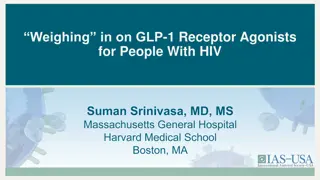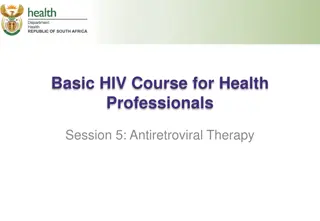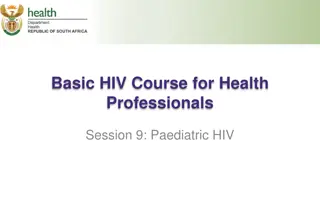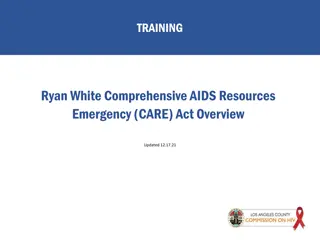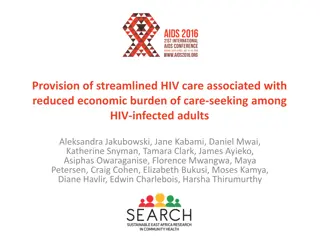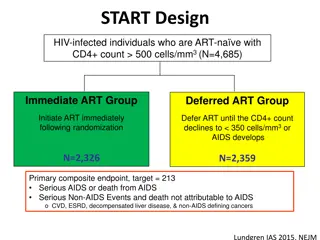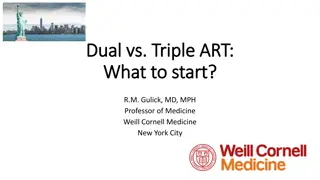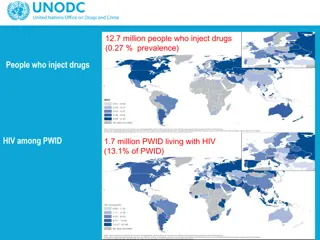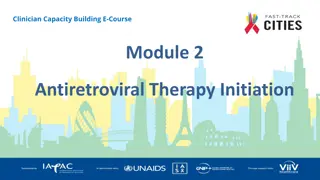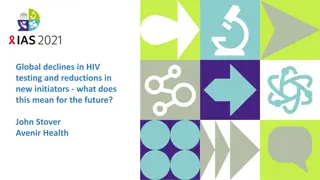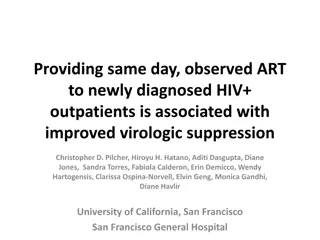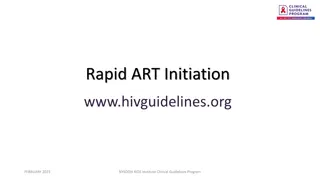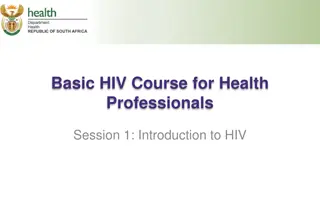Enhancing Antiretroviral Therapy Strategies for HIV Care
This module focuses on current recommendations and best practices for ART initiation, adherence, and retention in HIV patients. Topics include the benefits of ART, prevention benefits, and strategies to maximize treatment outcomes. The content emphasizes the importance of adherence and retention interventions in improving health outcomes for people living with HIV.
Download Presentation

Please find below an Image/Link to download the presentation.
The content on the website is provided AS IS for your information and personal use only. It may not be sold, licensed, or shared on other websites without obtaining consent from the author.If you encounter any issues during the download, it is possible that the publisher has removed the file from their server.
You are allowed to download the files provided on this website for personal or commercial use, subject to the condition that they are used lawfully. All files are the property of their respective owners.
The content on the website is provided AS IS for your information and personal use only. It may not be sold, licensed, or shared on other websites without obtaining consent from the author.
E N D
Presentation Transcript
Clinician Capacity Building E-Course Module 3 Antiretroviral Therapy Initiation Adherence and Retention in Care
Fast-Track Cities Initiative Attain the UNAIDS 90-90-90 targets Increase utilization of combination HIV prevention services Reduce to zero the negative impact of stigma and discrimination Establish a common, web-based platform for real-time monitoring of progress
Learning Learning Objectives Objectives The purpose of this module is to inform current recommendations and best practices for the initiation of ART and for increasing rates of treatment adherence and retention in care among ART patients. After completing this module, you will be able to: Explain the treatment and prevention benefits of ART Describe existing recommendations and the latest evidence on initiation of ART Describe how emerging HIV initiation, adherence and retention practices can maximize the proportion of your HIV patients who are virally suppressed 3
What We Know about Antiretroviral Therapy
ART substantially improves health and well-being for PLHIV PLHIV can now have a near-normal life span ART has sharply lowered AIDS-related deaths and disability The Health Benefits of Antiretroviral Therapy More than 6-fold decline in deaths in U.S. Continuous ART likely to serve as central HIV treatment strategy for some time Katz IT, et al, Marcus et al, Murray CJL et al. Grinsztejn B et al, Fidler S et al, HIV in the United States: At a Glance, 2018, Atlanta: U.S. Centers for Disease Control and Prevention EMPRANO ANRS 12136 Study Group, INSIGHT START Study Group
Clinical trials have found that ART sharply lowers the risk of HIV transmission Prevention benefits of ART have been confirmed in the real world (Vancouver, KwaZulu-Natal, PEPFAR studies) The Prevention Benefits of Antiretroviral Therapy No linked seroconversion in studies of serodiscordant partners (U=U) Sources: Montaner JS et al., Cohen M et al.. Rodger A et al., Montaner JSG et al., Tanser F et al., PHIA (Population-Based HIV Impact Assessment) Project, Data Summaries, https://phia.icap.columbia.edu/resources/.
Maximizing the Benefits of ART Initiating ART Adherence and retention interventions When to start ART What to use as first-line therapy Dolutegravir and pregnancy Why adherence and retention are important Peer interventions mHealth interventions Patient navigation Data to care Clinic practices
When to Start ART Treatment Guidelines The Importance of the Earliest Possible Treatment Initiation Fast-Tracking Treatment Initiation
Test-and-Treat: Clinical Guidelines ART is recommended for all individuals with HIV, regardless of CD4 count to reduce morbidity and mortality and to prevent new HIV infections NIH, European AIDS Clinical Society, IAS-USA. Australasian Society of HV Medicine Treatment must remain voluntary in all cases counseling and support should be given to patients who are not ready to begin ART Panel on Antiretroviral Guidelines for Adults and Adolescents, Guidelines for the Use of Antiretroviral Agents in Adults and Adolescents Living with HIV, Department of Health and Human Services, 2018, http://aidsinfo.nih.gov/guidelines. Guidelines Version 9.0, 2017, European AIDS Clinical Society. Saag MS et al., Antiretroviral Drugs for Treatment and Prevention of HIV Infection in Adults: 2018 Recommendations of the International Antiviral Society-USA Panel, JAMA 2018;320:379-396. Australasian Society for HIV, Viral Hepatitis and Sexual Health Medicine (ASHM) Sub-Committee for Guidance on HIV Management in Australia
Clinical benefit: educe morbidity and mortality Prevention benefits: Reducing duration of unsuppressed virus Melbourne: Duration of infectiousness among gay men fell five-fold from 49.0 months to 9.6 months 2007-2016 Changes in guidelines and recommendations cited Importance of the Earliest Possible Treatment Initiation Sources: Grinsztejn B et al.. Medland NA et al., TEMPRANO ANRS 12136 Study Group. INSIGHT START Study Group
Fast-Track Treatment Initiation Numerous cities have moved to provide same-day treatment initiation, including Melbourne, New York, San Francisco Same-day treatment initiation is associated with reduced loss to follow-up increased uptake of antiretroviral therapy increased viral suppression improved retention in care Same-day treatment initiation must always be voluntary Sources: Rosen S et al., Amanyire G et al., Pilcher CD et al., Labhardt ND et al Koenig SP et al. Bacon O et al., Stoov M et al., Ending AIDS: Progress towards the 90-90-90 targets, 2018; Geneva: United Nations Program on HIV/AIDS.
Demonstrates the impact of Fast-Track treatment initiation Citywide RAPID program links new HIV diagnoses to care within 5 days treatment initiated at the first visit From 2013 to 2016 reductions in time from diagnosis to care diagnosis to treatment initiation diagnosis to viral suppression Experience in San Francisco and New findings from Melbourne HIV incidence declined average time between diagnoses and undetectable viral load fell Melbourne For information on San Francisco s RAPID program: https://www.gettingtozerosf.org/wp-content/uploads/2016/09/20160822_citywide_rapid_protocol_v2.pdf
Similar results from Western Europe Days from diagnosis to initiation of ART Median & interquartile range EACS 2019 Abstract Book Nov 2019
3-drug regimens What to Start 2-Drug regimens Dolugetravir, Pregnant Women and Children
What to Start Recommended Initial Regimens for Most People DHHS European AIDS Clinical Society Australian Antiretroviral Guidelines follow US DHHS Guidelines with Australian commentary IAS-USA INSTI plus 2 NRTIs BIC/TAF/FTC DTG/ABC/3TC if HLA-B*5701 negative DTG plus (TAF or TDF)a plus (FTC or 3TC) RAL plus (TAF or TDF)a plus (FTC or 3TC) ABC/3TC + DTG ABC/3TC/DTG (Must be HLA-B*57:01 negative and HBsAg negative) Bictegravir/TAF/emtricatabine Dolutegravir/abacavir/lamivudine Dolutegravir plus TAF/emtricitabine TAF/FTC or TDF/FTC or TDF/3TC + DTG INSTI plus 1 NRTI DTG/3TC except for individuals with HIV RNA >500,000 copies/mL, HBV coinfection, or in whom ART is to be started before the results of HIV genotypic resistance testing for reverse transcriptase or HBV testing are available/emtricitabine TAF/FTC/BIC TAF/FTC or TDF/FTC or TDF/3TC + RAL qd or bid Panel on Antiretroviral Guidelines for Adults and Adolescents, Guidelines for the Use of Antiretroviral Agents in Adults and Adolescents Living with HIV, Department of Health and Human Services, July 2019 , http://aidsinfo.nih.gov/guidelines. Guidelines Version 10, Nov 2019, European AIDS Clinical Society. https://eacs.sanfordguide.com/art/initial-regimens-arv-naive-adults Saag MS et al., Antiretroviral Drugs for Treatment and Prevention of HIV Infection in Adults: 2018 Recommendations of the International Antiviral Society-USA Panel, JAMA 2018;320:379-396. HIV Management in Australasia ASHM https://hivmanagement.ashm.org.au/
What to Start Dolutegravir, Pregnant Women and Children DHHS European AIDS Clinical Society Australian Antiretroviral Guidelines follow US DHHS Guidelines with Australian commentary IAS-USA Providers should discuss the benefits of using DTG and the risk of NTDs with the person of childbearing potential, to allow the person to make informed decisions about care. DTG may be used as an alternative ARV for individuals who are of childbearing potential and trying to conceive and those who are sexually active and not using contraception. For individuals who are using effective contraception, DTG may be used as a recommended option Higher risk of neural tube defects if used preconception. Should be switched to another drug All individuals of childbearing age should have documentation of a negative pregnancy test result before starting dolutegravir and should be counseled regarding this potential risk More data are expected it is not yet clear whether other InSTIs pose a similar risk of neural tube defects. Panel on Antiretroviral Guidelines for Adults and Adolescents, Guidelines for the Use of Antiretroviral Agents in Adults and Adolescents Living with HIV, Department of Health and Human Services, July 2019 , http://aidsinfo.nih.gov/guidelines. Guidelines Version 10, Nov 2019, European AIDS Clinical Society. https://eacs.sanfordguide.com/art/initial-regimens-arv-naive-adults Saag MS et al., Antiretroviral Drugs for Treatment and Prevention of HIV Infection in Adults: 2018 Recommendations of the International Antiviral Society-USA Panel, JAMA 2018;320:379-396. HIV Management in Australasia ASHM https://hivmanagement.ashm.org.au/
Interventions to Enhance Adherence and Retention
Goal of treatment is viral suppression Prevents morbidity and mortality Reduces new infections A primary cause of treatment failure and drug resistance sub-optimal adherence or discontinuity of care Importance of Robust Adherence and Retention Sources: Guidelines Version 9.0, 2017, European AIDS Clinical Society
mHealth Interventions Interventions to Enhance Adherence and Retention Peer Support Patient Navigation Clinic Practice and Operations Data to Care Case Management and Referral
mHealth Interventions Mobile text messaging increase treatment adherence for a wide array of health issues Meta-analysis found text messaging roughly doubles the odds of medication adherence among patients with chronic diseases (studies generally relied on self-reports and were of short duration) moderate to high levels of satisfaction among patients Pager messaging increases retention Seattle: Significant association with increased retention at 3, 6 and 9 months (but no significant effect found on adherence) Different approaches to text messaging for adherence support automated, interactive Sources: Thakkar J et al., Bobrow K et al., Simoni JM et al., Garofalo R et al.
Peer Support Involving peers effective strategy for increasing treatment adherence Peers may be integrated into multi-disciplinary care teams (for more information on how to implement this approach: https://targethiv.org/library/integrating-peers-multidisciplinary-teams) Peer support groups (in your clinic or in the community) can increase adherence Sources: Thompson MA et al., Simoni JM et al., Integrating Peers into Multidisciplinary Teams, 2007, New York: Cicatelli Associations, Inc., https://targethiv.org/library/integrating-peers-multidisciplinary-teams. Community-Based Antiretroviral Therapy Delivery: Experiences of M decins Sans Fronti res, 2015, Geneva: Joint United Nations Program on HIV/AIDS.
Patient Navigation Peer-led navigation services have emerged as an important intervention across the HIV care continuum (linkage to care, retention in care, viral suppression) US CDC has officially designated patient navigation as an effective intervention for treatment adherence Navigation has proven especially effective for marginalized groups such as individuals who are released from prisons into the community For newly diagnosed individuals, the trained navigator builds rapport with the client, undertakes a psychosocial assessment, facilitates initial laboratory assessment and educates the client on needed prophylaxis Navigation is especially helpful in linking individuals, as needed, to other services such as substance use or mental health services People living with HIV are ideal peer navigators as they understand the challenges of a new diagnosis and recognize the difficulties of navigating often-fragmented and complex health and social service systems Sources: Mugavero MJ,. Koesler KA et al Schumann CL et al., U.S. Centers for Disease Control and Prevention, Effective Interventions: Patient Navigation (Adherence), https://effectiveinterventions.cdc.gov/stepstocare/topics/patient-navigation. Best Practices for Integrating Peer Navigation into HIV Models of Care, 2015, Washington D.C.: AIDS United.
Clinical Practice Strategies One-on-one adherence counseling is strongly recommended Clinic hours should be assessed Routinely following up with patients who miss appointments is warranted Sources: Thompson MA et al., Guidelines for Improving Entry Into and Retention in Care and Antiretroviral Adherence for Persons with HIV: Evidence-Based Recommendations From an International Association of Physicians in AIDS Care Panel, Ann Intern Med 2012;156:817-833. Milam J et al., Effect of a Brief Antiretroviral Adherence Intervention Delivered by HIV Care Providers, J Acquir Immune Defic Syndr 2005;40:356-363.
Data to Care Well-developed surveillance systems can detect markers for lack of linkage to care or discontinuity of care Depends on reporting of CD4 and viral load test results Re-engagement of people who fall out of HIV care is critical to attainment of 90-90-90 Globally, 1 in 5 people discontinue antiretroviral therapy within 12 months of treatment initiation Data to care approaches use markers to identify people who have no evidence of health monitoring in a period of time (e.g., 12 months) Lack of reported CD4 or viral load test Intervention to re-engage clients who are out of care and link them to HIV medical care Different models: Provider outreach, health department outreach, community worker outreach New York City s data-to-care model has achieved impressive results 75% of individuals who were out of care have been re-linked to HIV care High levels of viral suppression among clients who are re-linked to care For information on implementing Data to Care: https://effectiveinterventions.cdc.gov/docs/default-source/data-to- care-d2c/pdf-of-important-considerations.pdf?sfvrsn=0 Sources: Data to Care: Using HIV Surveillance Data to Support the HIV Care Continuum, Atlanta: U.S. Centers for Disease Control and Prevention, https://effectiveinterventions.cdc.gov/docs/default-source/data-to-care-d2c/pdf-of-important- considerations.pdf?sfvrsn=0. UNAIDS AIDSinfo database, 2018, http://aidsinfo.unaids.org. Hart-Malloy R, Tesoriero J, Data to Care: A Critical Tool for Ending AIDS in New York State, 2016, https://www.hiv.gov/blog/data-to-care-a-critical-tool-for-ending-aids-in-new-york-state.
Data to Care Well-developed surveillance systems detect markers for lack of linkage to care or discontinuity of care Re-engagement of people who fall out of HIV care critical to attainment of 90-90-90 Globally, 1 in 5 people discontinue antiretroviral therapy within 12 months of initiation Data to care approaches use markers to identify people who have no evidence of health monitoring in a period of time (e.g., 12 months) Interventions to re-engage clients Different models: Provider outreach, health department outreach, community worker outreach
Data to Care New York City s data-to-care model has achieved impressive results 75% of individuals who were out of care re-linked to HIV care High levels of viral suppression among clients who are re-linked to care For information on implementing Data to Care: https://effectiveinterventions.cdc.gov/docs/default-source/data-to- care-d2c/pdf-of-important-considerations.pdf?sfvrsn=0 Sources: Data to Care: Using HIV Surveillance Data to Support the HIV Care Continuum, Atlanta: U.S. Centers for Disease Control and Prevention, UNAIDS AIDSinfo database, 2018, Hart-Malloy R, Tesoriero J, Data to Care: A Critical Tool for Ending AIDS in New York State, 2016,
Case Management and Referral Case Management recommended for patients who have intensive social or structural issues such as food insecurity, housing issues or transportation needs For individuals with substance use disorders, directly observed therapy especially in the context of methadone maintenance services can improve adherence Patients should be screened, managed and treated for mental illness Sources: Thompson MA et al., Barker B et al., International AIDS Conference, Amsterdam, 2018, Abstract WEAX0101LB.
Case Management and Referral Case Management is recommended for patients who have intensive social or structural issues, such as food insecurity, housing issues or transportation needs For individuals with substance use disorders, directly observed therapy, especially in the context of methadone maintenance services, can improve adherence As mental health disorders can interfere with a person s ability to adhere to treatment, patients should be screened, managed and treated for mental illness Sources: Thompson MA et al., Guidelines for Improving Entry Into and Retention in Care and Antiretroviral Adherence for Persons with HIV: Evidence-Based Recommendations From an International Association of Physicians in AIDS Care Panel, Ann Intern Med 2012;156:817-833. Barker B et al., Engagement in methadone maintenance therapy associated with less time with plasma HIV-1 RNA viral load above 1500 copies/mL among a cohort of HIV-positive people who use drugs in Vancouver, Canada, International AIDS Conference, Amsterdam, 2018, Abstract WEAX0101LB.




